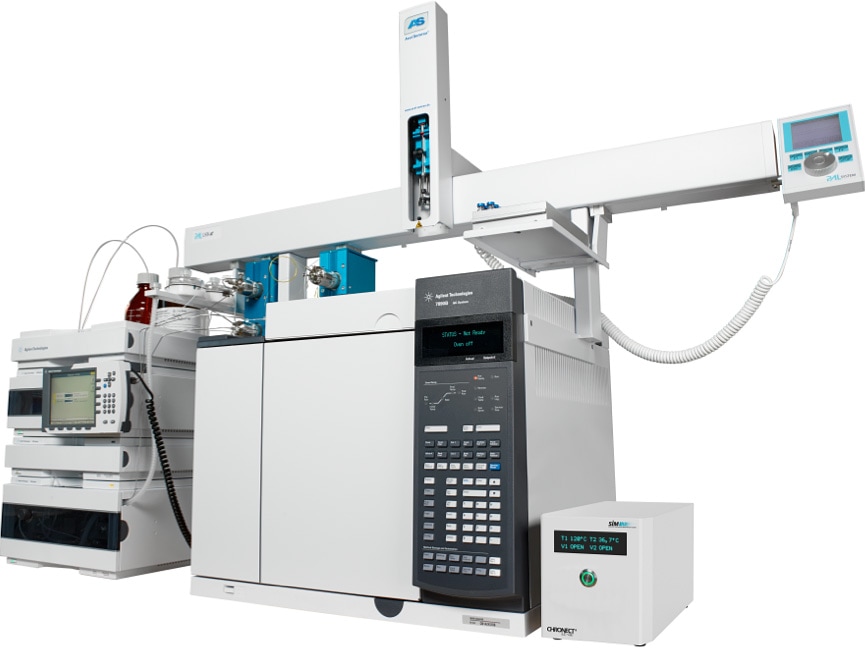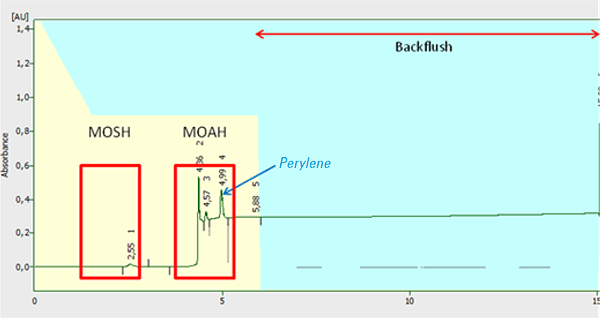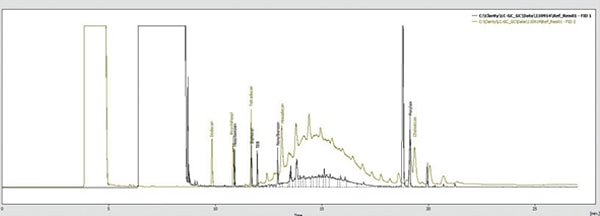Access Agilent eNewsletter January 2017

Accelerate analysis of mineral oil (MOSH/MOAH) with ready-to-go online LC-GC/FID coupling
Christian Gotenfels
Agilent LC Solutions Manager
Rolf Eichelberg
SIM GmbH, Managing Director
Determination of mineral oil contaminants in foodstuffs and packaging is increasingly important now that components of mineral oil are suspected of causing cancer. The method of choice for this demanding application is based on online LC-GC/FID coupling. Agilent value added reseller (VAR) partners SIM Scientific Instruments Manufacturer GmbH (Germany) and SRA Instruments (Italy) provide fully automated solutions for the analysis of saturated mineral oils (MOSH) and aromatic mineral oils (MOAH) in food. In this article, we describe briefly the MOSH/MOAH Analyzer from SIM GmbH.
Mineral oil contamination: a growing concern
Food may become contaminated with mineral oils from the raw materials, from contaminants introduced during the food manufacturing process, or by migration of mineral oil components from packaging materials (such as recycled cardboard). Both the European Food Safety Authority (EFSA) and the German Federal Institute for Risk Assessment (BfR) warn about adverse health effects of mineral oils in food. In particular, the aromatic mineral oils (MOAH) are suspected to be carcinogenic and mutagenic. The saturated mineral oils (MOSH) accumulate in the organs of the body and can damage them.
Recently, German media (press and TV) has raised concerns with mineral oil contamination in food—making this food safety issue a top focus of the industry and authorities.
Agilent LC-GC MOSH/MOAH Analyzer from SIM simplifies LC-GC coupling
An innovative solution has resulted from a successful collaboration between SIM (Scientific Instruments Manufacturer GmbH) and Axel Semrau, who optimized the original LC-GC method [1] by developing the module CHRONECT LC-GC. By combining LC and GC separations with a special valve setup, it is possible to determine the MOSH and MOAH fractions within a single analysis. SIM GmbH now offers this MOSH/MOAH Analyzer as a complete solution with proven Agilent LC and GC instrumentation and software (Figure 1). This combination delivers a reliable and robust solution for the determination of mineral oil fractions in routine analysis.

Figure 1. Agilent online LC-GC solution enables the separation and quantitation of both MOSH and MOAH fractions with a single 30-minute chromatographic run.
The MOSH/MOAH Analyzer consists of:
- Agilent 1260 Infinity II LC
- CHRONECT Robotic from Axel Semrau
- Agilent 7890B GC with two FIDs
- CHRONECT LC-GC coupling
- Data system with controlling and evaluation software (Chronos and OpenLAB CDS ChemStation)
- Accessories and consumables
Reliably transfer 450-µL fractions from LC to GC
With the online LC-GC method, the normal phase liquid chromatography works as a sample preparation step to separate the MOSH and MOAH fractions as well as the interfering lipid and matrix components. Subsequently, the separated MOSH and MOAH fractions are transferred to the GC. The key component of the system is the CHRONECT LC-GC coupling developed by Axel Semrau. It consists of an intelligent valve setup that uses the retention gap technique and solvent vapor exit to transfer both fractions of interest (450 µL each) from the LC to the GC system without any sample discrimination. This setup reduces the risk of contamination and enables low limits of quantitation (for example, for rice and noodle samples, 0.5 mg/kg each for MOSH and MOAH).

Figure 2. HPLC chromatogram with the marked MOSH and MOAH fractions that are transferred to the GC system.

Figure 3. GC injection of a contaminated rice sample and the resulting signals from the MOSH (green) and MOAH (black) channels.
Dual detectors provide twice the sample throughput
To double sample throughput and cut the solvent consumption in half, two FID channels in the GC are used in parallel. This technique significantly reduces the cost per sample.
These chromatograms show the 30-minute LC-GC analysis of a single sample:
- HPLC UV detector signal (Figure 2)
- FID signal of the MOSH fraction (green trace in Figure 3)
- FID signal of the MOAH fraction (black trace in Figure 3)
Online LC-GC system accelerates MOSH and MOAH analysis
Because mineral oil contaminants in foods and their packaging are suspected carcinogens, Agilent collaborates closely with other providers to deliver automated solutions for the analysis of mineral oil saturated hydrocarbons (MOSH) and mineral oil aromatic hydrocarbons (MOAH). The LC-GC MOSH/MOAH Analyzer from our VAR partner SIM expedites the sensitive and simultaneous determination of MOSH and MOAH fractions in just 30 minutes. Extensive automation delivers the foundation for high sample throughput in 24/7 environments. And you can expand this solution for other applications like sterols or polycyclic aromatic hydrocarbons (PAHs). For more details, contact SIM or your Agilent representative.
Reference
- Biedermann, M., Fiselier, K., and Grob, K., J. Agric. Food Chem. 2009, 57, 8711-8721.
Stay informed about the applications that are important to you
Subscribe to Access Agilent
Our free customized
monthly eNewsletter
Article Directory – January 2017
All articles in this issue
 Best practices for food safety laboratories: highlights from inaugural Agilent—AOAC workshop
Best practices for food safety laboratories: highlights from inaugural Agilent—AOAC workshop ICP-MS and ICP-OES methodology enables comprehensive analysis and quantification of elemental extractables and leachables
ICP-MS and ICP-OES methodology enables comprehensive analysis and quantification of elemental extractables and leachables Ask the Expert: Is there a simple, cost-effective alternative to traditional manual operation while improving precision in GC analysis?
Ask the Expert: Is there a simple, cost-effective alternative to traditional manual operation while improving precision in GC analysis? Case study: Agilent customer collaboration delivers robust LC-QQQ method to quantify vitamin B12 absorption
Case study: Agilent customer collaboration delivers robust LC-QQQ method to quantify vitamin B12 absorption Accelerate analysis of mineral oil (MOSH/MOAH) with ready-to-go online LC-GC/FID coupling
Accelerate analysis of mineral oil (MOSH/MOAH) with ready-to-go online LC-GC/FID coupling Preconfigured GC/MS/MS analyzer puts you on the fast track to pesticide analysis
Preconfigured GC/MS/MS analyzer puts you on the fast track to pesticide analysis Tip: Getting the best value from your UHPLC analyses
Tip: Getting the best value from your UHPLC analyses
Figure 1

Agilent online LC-GC solution enables the separation and quantitation of both MOSH and MOAH fractions with a single 30-minute chromatographic run.
Figure 2

HPLC chromatogram with the marked MOSH and MOAH fractions that are transferred to the GC system.
Figure 3

GC injection of a contaminated rice sample and the resulting signals from the MOSH (green) and MOAH (black) channels.